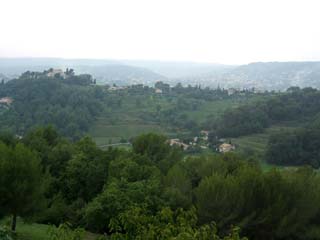
|
The trip to Vence winds its way inland through the
French countryside on a comfortably wide road (by European
standards). September is the rainy season (such as it is) so
everything is green again after the dry summer. This must also be
the agreed upon time to burn leaves because the air has been smoky for
weeks.
|

|
Old Vence is mostly
dedicated to restaurants and ateliers (artist's working
galleries). Thankfully, the normal tourist trinket shops are
largely absent. This wall is part of the Cathedral which was
built on the sight of a Roman temple to Mars. The stone next to
the door of this atelier is an inscription from Roman times in honor of
"The daughter of
Mucius" who was the wife of a "Decurion of Ventium". Just a few
obscure lives out of generations of people who have molded this
spot. Vence is so
littered with history and
art that the French at various times have felt the need to simply
demolish parts of it. The French revolution was particularly
harsh because anything associated with the aristocracy, including art
and even religious sculpture, was abused as an
offense to the revolution. And the Futurists thought they were
radical.
|
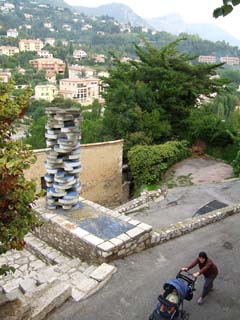
|
The old Roman road to
"Ventium" still winds it's way up the side of the hill to a gate that
once had a drawbridge and a lookout tower. Vence was once
considered "the city of towers" but now only one remains. This
sculpture "Pourpol" was a gift from the Canadian sculptor, James
Ritchie.
|
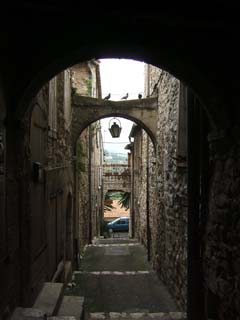
|
The roads in old Vence were strictly for walking or
perhaps a small cart. This one steps down radially from the
center
of town through a tunnel under the building above and through this
narrow
stairway to where the ramparts once were.
|
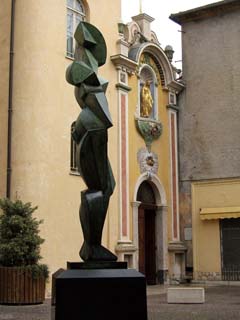
|
This abstraction
"La Vencoise" (woman from Vence) by J.
Ritchie stands in the central square near the "Cathedral of
Vence". On the day I visited, the upper gallery of the cathedral
was open for an exhibition of "the Calvary Statues" which were painted
wood sculptures of various scenes depicting the crucifixion of
Christ. Some of the sculptures had been damaged, vandalized or
burned in the French revolution and later repaired so it was difficult
to tell what was the original form. Most were fairly naive
carvings, all but one unsigned, that emoted a good deal of sincerity
to their religious purpose.
|
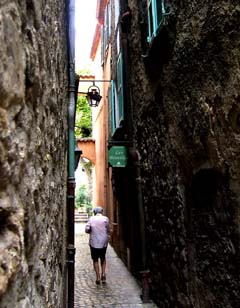 |
This tiny road is
heading
south out of the main square, which is not large itself. Vence
has a series of placards in French and English that describe various
interesting historical facts about Vence. One of which was that
the ateliers and restaurants that line the larger roads were once
kitchens and stables for
the houses that surround. Water was obtained at the public
fountain. When everything is so heavy with history, literally
thousands of years of accumulated effort, and layered with small
adjustments to accommodate changing lifestyles from tribal to roman to
medieval to modern, it is hard to grasp the
full meaning of these roads in human terms. Once they afforded
protection from
marauding tribes. Now they are open for the
enjoyment of tourists. As I was passing, a maintenance crew was
working on a sewer and the image (and olfaction) of these streets full
of sewage tossed out of the windows above came to mind. Many of
the stones on the paths are worn smooth from the gentle shuffle of how
many lives?
|
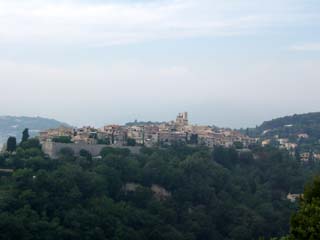
|
The trip to and from
Vence passes a couple of medieval towns. This is the stunning
view of St Paul de Vence on the way to Vence.
|
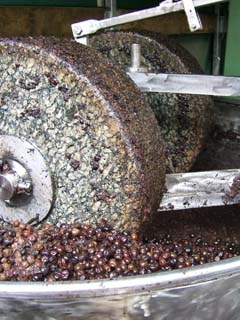
|
I returned a few days
later with the family for a festival of country traditions. This
is sort of a "county fair" French style where local craftspeople show
their wares and skills. The French use the word "artisanal" to
describe people who make handcrafted products with a good deal of care
rather than selling manufactured items. The result is the broad
support
for traditional methods as being superior because of the slight
variation in product compared to what is considered "over refined"
manufactured goods. This olive press uses granite wheels to crush
the fruit in the same way that it must have been done since the Greeks
brought olives to this part of France 2500 years ago--minus the
stainless steel structure and the electric motor instead of
slaves.
|

|
The French are very
fond of honey. It comes in a wide variety from different regions,
flowers, textures and level of processing. Lavender honey is a
specialty of Provence. The hive at right was on display between
panes of plexiglass. The queen bee is on the left (with the
yellow spot on her back) tending to her brood as they collect honey.
|

|
Being from rural
Virginia, I have a fascination for moonshine. Here it is being
made with a license. A wood fire was used to heat some fifty
gallons of liquid to just the right temperature for the alcohol
to evaporate. The "steam" was then condensed through a coiled
tube
immersed in cold water. The output is shown dripping off a lemon
leaf into a pail. Later in the day, small samples were freely
served to a happy crowd. The still looked like it had been beaten
out of copper by someone's great-great-grandfather. It probably
was.
|

|
Here is one of the
quiet back streets of old Vence. The houses on the left were
built against the ramparts of the city beginning in the 15th
century. Somewhere below them are signs of the Romans, the
Ligurians and prehistoric tribes before that.
|










